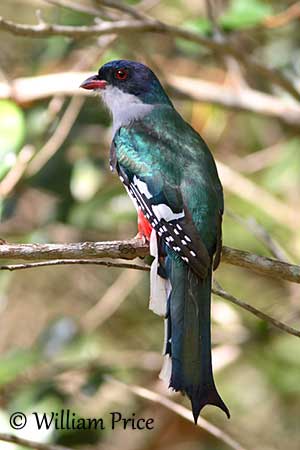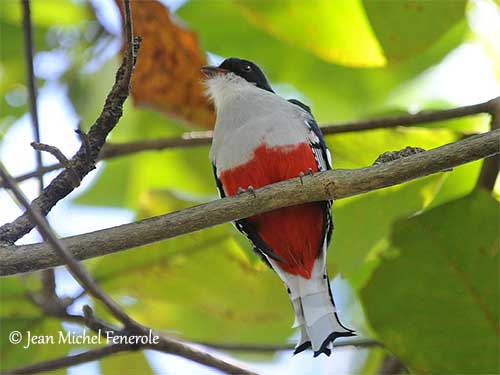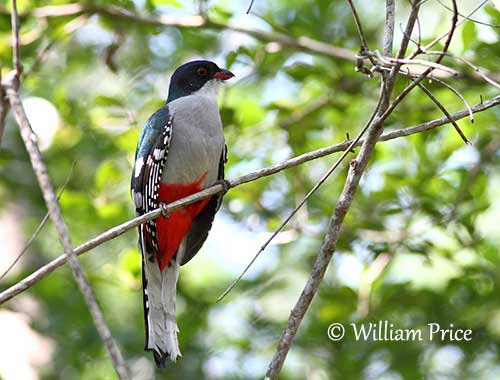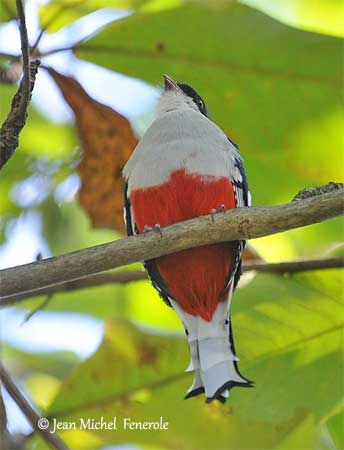
Fr: Trogon de Cuba
Ang: Cuban Trogon
All: Kubatrogon
Esp: Trogón Tocororo
Ita: Trogone di Cuba
Nd: Cubaanse Trogon
Sd: Kubatrogon
Photographers:
Jean Michel Fenerole
Photos d’Oiseaux du monde
William Price
PBase-tereksandpiper & Flickr William Price
Text by Nicole Bouglouan
Sources:
HANDBOOK OF THE BIRDS OF THE WORLD Vol 6 by Josep del Hoyo-Andrew Elliott-Jordi Sargatal - Lynx Edicions, 2001 - ISBN: 848733430X
BIRDS OF THE WEST INDIES – by Herbert Raffaele, Kristin Williams et Tracy Pedersen – Helm – ISBN: 9780713649055
L’ENCYCLOPEDIE MONDIALE DES OISEAUX - Dr Christopher M. Perrins - BORDAS - ISBN: 2040185607
Wikipedia, the free encyclopaedia
Wikipedia, la enciclopedia libre
Cuba Explorer - Introducing Our Cuba’s logo and mascot
Círculo Güinero de Los Angeles - Cuba’s National Bird
Cuba Naturaleza Biodiversity - Cuban Trogon, the national bird of Cuba
Cuban Trogon
Priotelus temnurus
Trogoniformes Order – Trogonidae Family
INTRODUCTION:
The Cuban Trogon is part of the subfamily Trogoninae which includes the American trogons.
This species has been chosen as the national bird of Cuba, because its red, white and blue plumage reflects the colours of the Cuban flag. The Cuban Trogon is endemic to Cuba where it is also known as “Tocoloro” derived from its repeated call “toco-toco-toro-tocoro”
It frequents both dry and wet forest and degraded former forest. It is common throughout the range and the population is currently stable.
This beautiful bird cannot live in captivity because it dies of sadness if caged.
DESCRIPTION OF THE BIRD:
Biometrics:
Length: 23-25 cm
Weight: 47-75 g
The Cuban Trogon adult of nominate race has glossy blue-green upperparts from mantle to rump, becoming dark green towards the scalloped tail. On the upperwing, we can see large white spots on coverts, and regular white notches on outer webs of primaries, but no barred wing panel like in numerous Trogonidae.

The uppertail is dark green-blue, but the central pair of rectrices shows bronze-blue inner webs. All rectrices show excised tips, giving the tail a peculiar shape. The central feathers end in ragged tips, whereas the three outer pairs of feathers have blackish base and white notches on outer webs. They protrude at the outer edge. This is especially noticeable when the tail is viewed from below.
On the underparts, the breast is greyish-white, whereas belly and undertail-coverts are red. The undertail feathers are white.
On the head, the face is blackish while crown and nape are violet-blue. Malar area, neck sides, chin and throat are white.
The bill is reddish with dark grey culmen. The long tongue has split tip related to its feeding behaviour. The eyes are red. Legs and feet are pinkish with black claws.
Male and female have similar plumage but the female is slightly smaller and has paler red belly.
The juvenile is not currently described.

SUBSPECIES AND RANGE:
The Cuban Trogon has two subspecies.
P.t. temnurus is found in Cuba, including some large cays N of Camagüey Province (Guajaba and Sabinal).
P.t. vescus occurs on Isle of Pines. This one is slightly smaller than nominate but it has larger bill.
HABITAT:
The Cuban Trogon is common in all forested areas, including wet and dry forests and degraded former forest, shrubbery and bushes near rivers. It usually remains in shady areas within these habitats. It also occurs in dense pine forest with tall trees. This species can be found at all levels, but it is commoner in mountainous areas.
CALLS AND SONGS: SOUNDS BY XENO-CANTO
The Cuban Trogon sings from perch, usually a branch in tree. It utters a pleasant 3-4 syllables “toco-toco-tocoro…” usually repeated for long periods, interspersed with pauses. During this song, the tail is almost trembling.
It also produces hoarse barking, various clucks, and if alarmed, a short, low mournful call nearly impossible to locate.
BEHAVIOUR IN THE WILD:
The Cuban Trogon feeds mainly on flowers, nectar, fruits, insects and buds, but flowers and nectar are its main food. While feeding, it hovers like a Tyrannidae.
They are usually found in pairs. They spend most of the day perched motionless in a distinctive upright posture. They are more active in the early morning and the late afternoon.
The Cuban Trogon has 1st and 2d toes pointing backwards, and 3d and 4th toes pointing forwards. This is the “unique trogon pattern” very efficient for perching on tree branches.

During the breeding season, they are monogamous and both parents share all the nesting duties. They are cavity-nesters.
Pair-formation and displays are poorly known. It appears that in any species, both mates maintain a loose contact and re-mate in the following season.
We can suggest that the peculiar pattern and shape of wings and tail is used during displays, especially flight displays. These flights accompanied by calls are also used as aggressive signals to other males.
The Cuban Trogon is sedentary in its range, and only moves locally and seasonally between forest, shrubland and adjacent habitats.
The noisy flight is often performed only over short distances in undulating pattern. They often fly in pairs while giving loud squawks. But they are mostly clumsy fliers. They hover while feeding.
REPRODUCTION OF THIS SPECIES:
The breeding season takes place between May and August.
The Cuban Trogon nests in natural cavities in trees, often abandoned woodpecker’s nest, or usually a hole in decayed stump or tree trunk.
The female lays 3-4 white eggs with slight bluish tinge. The incubation lasts 17-19 days, shared by both adults. The chicks are fed with masticated food including fruits, berries, nectar and insects. They fledge about 17-18 days after hatching.
PROTECTION / THREATS / STATUS:
The Cuban Trogon is common and widespread throughout Cuba, but it is rarer on Guajaba, Romano and Sabinal.
The subspecies P.t. vescus was formerly widespread in the southern part of Isle of Pines, but it is now uncommon.
The population is suspected to be stable and the Cuban Trogon is currently evaluated as least Concern, with an estimate of 5000 breeding pairs (Cuba Explorer).
